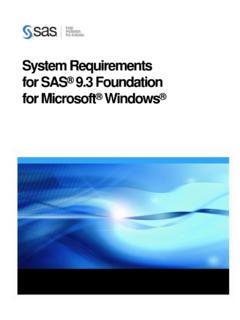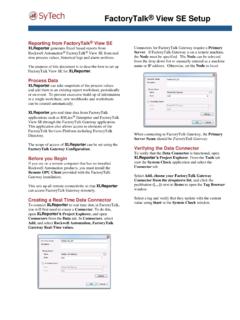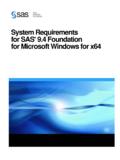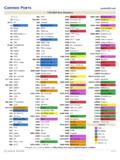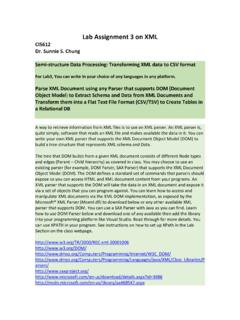Transcription of RSView 32 Setup - thereportcompany.com
1 RSView 32 Setup Reporting from RSView 32 XLReporter generates Excel based reports from Rockwell Automation RSView 32 using current process values in the tag database, historical logs and alarm archives. The purpose of this document is to describe how to Setup RSView32 for XLReporter. Process Values XLReporter can take snapshots of the process values and add them to an existing report worksheet, periodically or on event. To prevent excessive build-up of information in a single worksheet, new workbooks and worksheets can be created automatically. XLReporter gets live process values from RSView32 by communicating with the RSView32 OPC server . Before you Begin In order for XLReporter to communicate with RSView32, the machine where XLReporter is installed must also have the OPC core components installed.
2 The OPC core components are provided in the tools folder of the XLReporter install CD or from If XLReporter is installed on a PC that is remote to RSView32 then a number of settings need to be configured on both the server and client machines. This includes having matching Windows user accounts on both machines and enabling DCOM on the machine where RSView32 is installed. For a detailed explanation of what is needed, please read the OPC Training Institute document OPC_and_DCOM_5_things_you_need_to_know that is provided in the Tools folder of the XLReporter install CD or from Enabling the OPC server By default, the RSView32 OPC server is not enabled.
3 To enable OPC server , open the RSView32 Project Manager and under the Edit Mode tab select System, Startup to open the Startup Editor. Startup Editor Under the Startup tab, check OPC/DDE server . Restart the RSView32 project so that it runs with this setting. Creating a Real Time Data Connector To connect XLReporter to RSView32, you will first need to create a Data Connector. To do this, open XLReporter s Project Explorer, and open Connectors from the Data tab. In Connectors, select Add, and select Rockwell Automation, RSView32 Real-Time values. RSView Real Time Connector Connectors for RSView32 require a Primary server . If the Primary server is on a remote machine, the Node must be specified.
4 The Node can be selected from the drop down list or manually entered as a machine name or IP address. To connect to RSView32 the server Name should be set to Verifying the Data Connector To verify that the Data Connector is functional, open XLReporter s Project Explorer. From the Tools tab start the System Check application and select the Connector tab. Select Add, choose your RSView32 Connector from the dropdown list, and click the browser pushbutton ([..]) next to Items to open the Tag Browser window. Select one or more tags and verify that they update with the current value using Start in the System Check window. Writing Data Back to RSView32 As part of generating reports, XLReporter can also write data back to the RSView32 OPC server .
5 This can be used to indicate a report is done or to write back some calculated values from the report. By default, RSView32 does not accept values from external programs like XLReporter. The command RTDATAWRITEENABLE needs to be added to the macro of the RSView32 project designated to run on startup. Macros are accessed in the RSView32 Project Manger under the Edit Mode tab by selecting Logic and Control, Macro. Startup Macro To designate a macro for startup, in the Project Manager access the Startup Editor, check Startup Macro and select the macro to run from the available list. Historical Data With process data stored in a database, the variety of reports that can be produced by XLReporter increases many fold.
6 In addition to raw values, informative metrics such as run times and statistics are obtained by simply selecting the tags and time frame of interest. hourly average, maximum and minimum for each hour of the day. XLReporter performs raw calculations and time weighted calculations. The time weighted calculations would be used when the data is not logged periodically logging on change. Selecting a Database In order to produce historical reports, the process data in RSView32 has to be stored in a third party database. The choice of database is usually governed by the number of the process values, the frequency at which they are being stored and the length of time the values have to remain in the archive before they are purged.
7 Examples of databases are Oracle Database 11g, microsoft Access, SQL server , SQL server Express and Oracle mysql . The SQL server Express and mysql are designed to handle larger data volumes than Access and are available on the Internet at no cost. Oracle Database and SQL Sever would be used for large volumes of data. Note for microsoft Access users. When selecting Access as the database, an empty Access database can be created off-line and moved to the target system avoiding the need for an Access license on the target system. Creating a Data Source Name (DSN) RSView32 uses a data source name (DSN) to reference the database it is using to store its information.
8 The DSN should be defined before any history configuration is performed in the RSView32. To create a DSN, from XLReporter s Project Explorer, under the Tools tab, select Database, DSN Settings. Click the System DSN tab to display all the currently configured DSN s on the system. Click New to create a new System DSN. Create New Data Source Select the driver for the database to which RSView32 will log data. Based on the driver selected, complete the DSN Setup . Defining Data Log Models Data log models contain all the settings required for RSView32 to log historical data. To create a data log model, access the RSView32 Project Manager and under the Edit Mode tab select Data Log, Data Log Setup .
9 On the Setup Tab type a Description and Log File Identifier String. The log file identifier string is used to name the backup file if, for some reason, logging to the database has been prevented. Data Log Model Setup If, for some reason, values are logged to the backup file (*.OBF), the command DataLogMergeToPrimary can be used to merge the values in the file back to the database as follows: DataLogMergeToPrimary file specification where file specification is a relative or absolute reference to the data log model name. If the model name has a space in it, enclose the name in quotes, , "Waste Water". Set the Storage Format to ODBC and set ODBC Data Source with the DSN name created previously.
10 If the database requires the user log in, check Login Required and specify the User Id and Password to log into the specific database. Click Create Tables to create the TagTable, FloatTable and StringTable tables in the database. On the Paths Tab, specify the ODBC backup path, if required. The total number of characters and spaces allowed for the path and name is 255. On the File Management Tab, specify a time period after which records in the database will be purged. On the Log Triggers tab, specify how the logging of tag values will be triggered periodically, on change or on demand. The on demand option will log data when the DataLogSnapshot command is issued.


